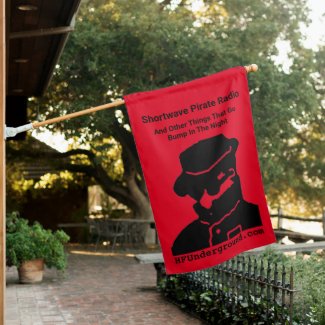2
« on: May 24, 2024, 1555 UTC »
Tune in time: 1530 UTC
G8JNJ Wessex, UK SDR.
26.200 MHz 26200 kHz - POCSAG paging signals, various signal strengths
26.220 MHz 26220 kHz - Paging signals - wideband, narrowband and very wide (16 kHz - 18 kHz BW) POCSAG
26.250 MHz 26250 kHz - POCSAG paging, FM carrier on frequency during "idle" time
26.350 MHz 26350 kHz - POCSAG paging, various strengths...also a weak FM carrier on frequency
26.500 MHz 26500 kHz - POCSAG paging, FM carrier on frequency during "idle" time
26.545 MHz 26545 kHz - POCSAG paging signals, intermittent activity
26.550 MHz 26550 kHz - POCSAG signals, narrow and wide band
26.600 MHz 26600 kHz - Very active pagers on this frequency 26.6 MHz 26.6MHz 26,600 kHz POCSAG
26.605 MHz 26605 kHz - Paging signals, narrowband POCSAG, sporadic signals, wideband POCSAG noted at 1538 UTC
26.630 MHz 26630 kHz - Wideband POCSAG paging signals, some SIO 555 very strong
26.645 MHz 26645 kHz - POCSAG signals, including 14-15 kHz wide signals
26.650 MHz 26650 kHz - Paging signals noted, roughly as frequent as 26.600 MHz or 26.900 MHz
26.655 MHz 26655 kHz - Sporadic paging signals on 26.655MHz
26.695 MHz 26695 kHz - POCSAG paging signals, numerous signals mixing together, constant activity
26.695 MHz 26695 kHz - POCSAG paging signals - narrowband signals
26.700 MHz 26700 kHz - Paging signals - POCSAG, intermittent use
26.705 MHz 26705 kHz - POCSAG signals - noted once every 30-40 seconds, narrow and wide POCSAG
26.735 MHz 26735 kHz - Wide and narrow POCSAG pager signals
26.745 MHz 26745 kHz - Non stop paging signals, just like 26.695 MHz, S9 + peak signal strength
26.750 MHz 26750 kHz - POCSAG paging and narrowband non-POCSAG signals (6 kHz bandwidth narrow)
26.750 MHz 26750 kHz - FM carrier on frequency during "idle" non-paging periods (very heavy QRM)
26.755 MHz 26755 kHz - Paging signals, pretty frequent use, but not nonstop like 26,695 and 26,745
26.785 MHz 26785 kHz - POCSAG - various bandwidths and signal strengths noted
26.800 MHz 26800 kHz - POCSAG pager signals, very busy at points
26.815 MHz 26815 kHz - Pager signals mixing with weak FM voice on frequency, nonstop signals just like 26.695MHz and 26.745MHz
26.835 MHz 26835 kHz - POCSAG - various bandwidths and signal strengths noted
26.850 MHz 26850 kHz - Sporadic POCSAG signals noted
26.885 MHz 26885 kHz - Sporadic POCSAG, extremely strong wide band paging signal 18 kHz BW!!
26.900 MHz 26900 kHz - Very strong POCSAG on frequency
26.950 MHz 26950 kHz - Narrowband POCSAG signals, other data link signals noted
27.300 MHz 27300 kHz - POCSAG paging signals basically nonstop on this frequency
27.350 MHz 27350 kHz - Narrow band POCSAG noted 27,350kHz 27.35 MHz
27.360 MHz 27360 kHz - Sporadic POCSAG paging signals, heavy CB radio QRM 27.355 MHz and 27.365 MHz
27.425 MHz 27425 kHz - POCSAG signals noted at 1546 UTC and 1547 UTC
27.450 MHz 27450 kHz - FM carrier during idle periods, POCSAG paging and other data also on frequency
27.475 MHz 27475 kHz - Narrowband paging signals - 6-7 kHz wide BW, fair to weak signals
27.500 MHz 27500 kHz - POCSAG, 12-13 kHz wide signals, very similar to 27.505 MHz signals
27.505 MHz 27505 kHz - POCSAG pager signals on frequency, center frequency varies, 27.504 MHz, 27.5055 MHz, 27.506 MHz..
27.510 MHz 27510 kHz - 20 kHz wide POCSAG signals noted, also narrowband 6-8 kHz wide signals on frequency
27.550 MHz 27550 kHz - POCSAG signals, no doubt causing havoc on 27.555 MHz USB
27.650 MHz 27650 kHz - POCSAG paging signals, similar to those noted on 26 MHz band
27.750 MHz 27750 kHz - POCSAG noted, idle FM carrier when no paging signal being sent
27.760 MHz 27760 kHz - Data link frequency, roughly 10-12 kHz bandwidth - paging signals also noted on frequency
27.845 MHz 27845 kHz - POCSAG signals, similar to 27.850 MHz (offset frequency)
27.848 MHz 27848 kHz - POCSAG pager signals, offset frequencies 27.847 MHz, 27.848 MHz, similar to 27.505 MHz signals
27.850 MHz 27850 kHz - See 27.845MHz and the offset 27.847 MHz 27.8475 MHz signals
27.900 MHz 27900 kHz - Sporadic data signals, narrowband POCSAG also noted
29.750 MHz 29750 kHz - Sporadic POCSAG paging signals, 29.8 and 29.9 MHz are well-known, 29.75 MHz is a new one (I think)
29.800 MHz 29800 kHz - Pager frequency, active with various bandwidth POCSAG pager signals 29,8 29,800 kHz
29.900 MHz 29900 kHz - POCSAG paging active, wide and narrow band signals 29,900 kHz 29.9MHz


